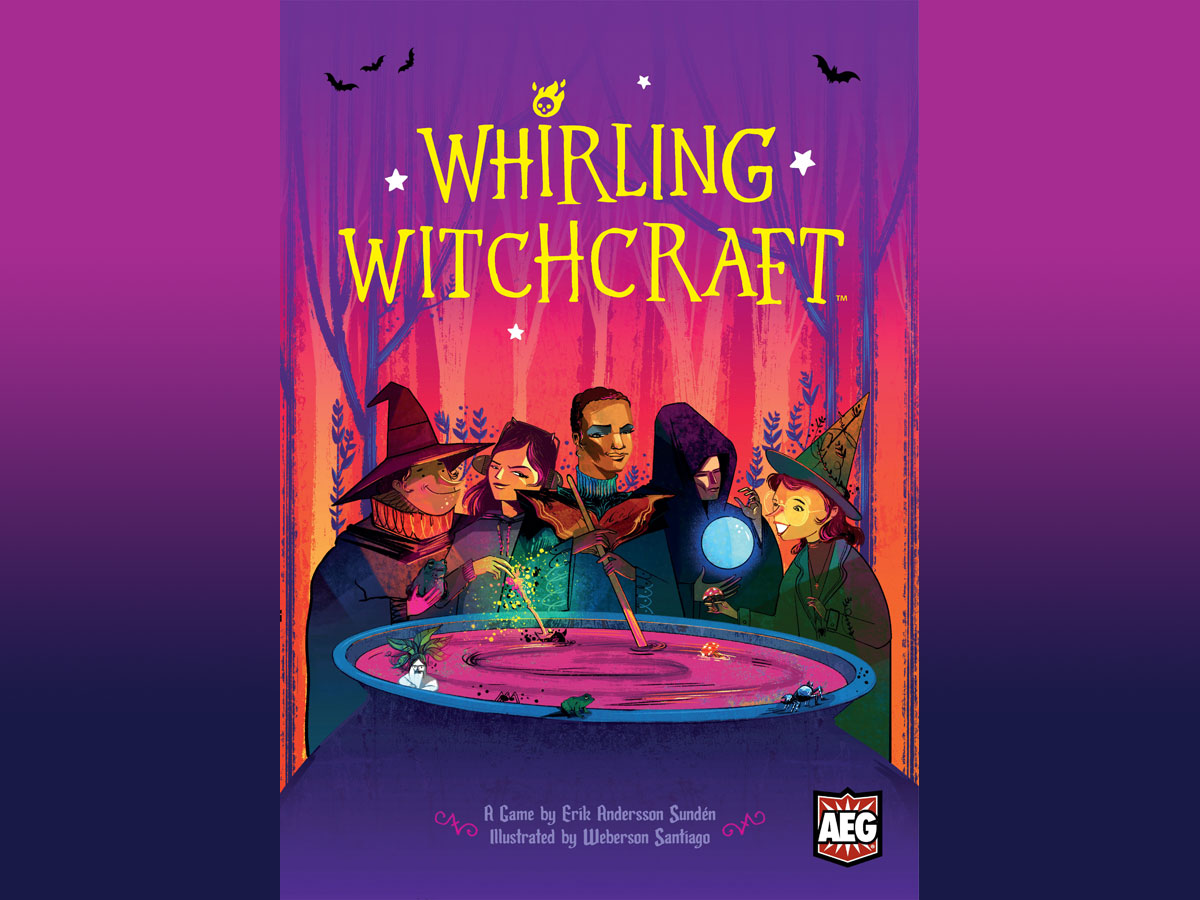Combine magical ingredients to make powerful potions, but be careful not to blow things up!
What Is Whirling Witchcraft?
Whirling Witchcraft is a game for 2 to 5 players, ages 14 and up, and takes about 30 minutes to play. It retails for $39.99 and is available in stores or directly from AEG. Although the box says 14 and up, I’ve played with younger kids and they’ve been able to learn the rules just fine, and there isn’t any thematic content that seems inappropriate.
Whirling Witchcraft was designed by Erik Andersson Sundén and published by AEG, with illustrations by Weberson Santiago.

Whirling Witchcraft Components
- 5 Player boards
- 5 Cauldrons
- 15 Arcana tokens (3 per player)
- 5 Reference cards
- 60 Recipe cards
- 17 Personality cards
- 170 Ingredient cubes:
- 20 Heart of Shadow (black)
- 30 Mandrake (white)
- 40 Mushroom (red)
- 40 Spider (blue)
- 40 Toad (green)
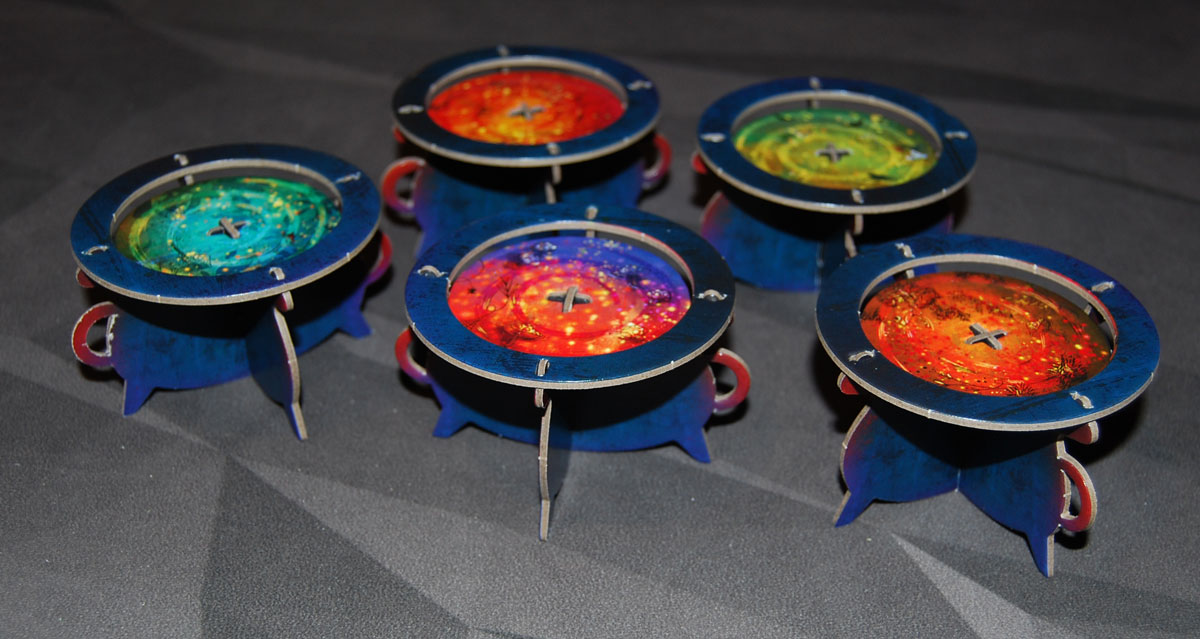
The cauldrons are cardboard constructs that you’ll need to punch out and assemble before the first time you play the game. They’re pretty easy to put together, and they serve as a little tray with a lip that you’ll use to pass cubes to the next player. While the cube passing could have been done with just a flat tile or nothing extra at all, the cauldrons are pretty cute, and help add to the atmosphere of the game. The potions in the cauldrons vary a bit in color, but don’t match up exactly with the player boards (which is fine, given that the cauldrons will be passed around).

The player boards are small square boards with five tracks for the different ingredients, plus a “Witch’s Circle” symbol at the top of the board. Each board has a unique circle as well as surrounding artwork, which is a nice touch. The ingredient tracks here—as well as the ingredients on the recipe cards—have an icon that helps to distinguish them beyond just the colors, though the ingredient cubes themselves are just painted wooden cubes, so I’m not sure how well this would work for red-green color blind players.
Speaking of the cubes, the one issue we’ve run into, particular when playing with the full player count, is that we run out of cubes. Each player can have as many as 9 of the more common ingredients on their workshop, not counting the ones that might be in cauldrons—for a 5-player game that’s 45 toads, for instance. While it’s not likely that many ingredients are going to be maxed out for every player, we’ve found it’s pretty common for at least one ingredient to run out while people are waiting for others. But since the game isn’t piece-limited—that is, you aren’t meant to “run out” of anything—it may help to supplement the game with your own cubes. Another option is to have players use one cube per ingredient as a tracker on their boards, rather than filling up the track with cubes, though there are reasons that can be tricky as well.
How to Play Whirling Witchcraft
You can download a copy of the rulebook here.
The Goal
The goal of the game is be the first to collect 5 ingredients in your Witch’s Circle by overflowing your nemesis’s workbench.

Setup
Shuffle the recipe cards and deal 4 cards to each player. Place the recipe deck and the ingredient tokens within reach.
Give each player a player board, a cauldron, and a reference card, along with 3 arcana tokens. You also get a personality card—either use the initiate cards for the learning game, or deal 2 personality cards to each player and let them choose one to keep. The personality card is placed face-up near your board. Some personality cards are recipes (explained later), and some have ongoing abilities.
Each player collects the starting ingredients shown on the back of their personality card and places them on their workbench, and also adjusts their arcana tokens on their reference card if their personality card indicates.
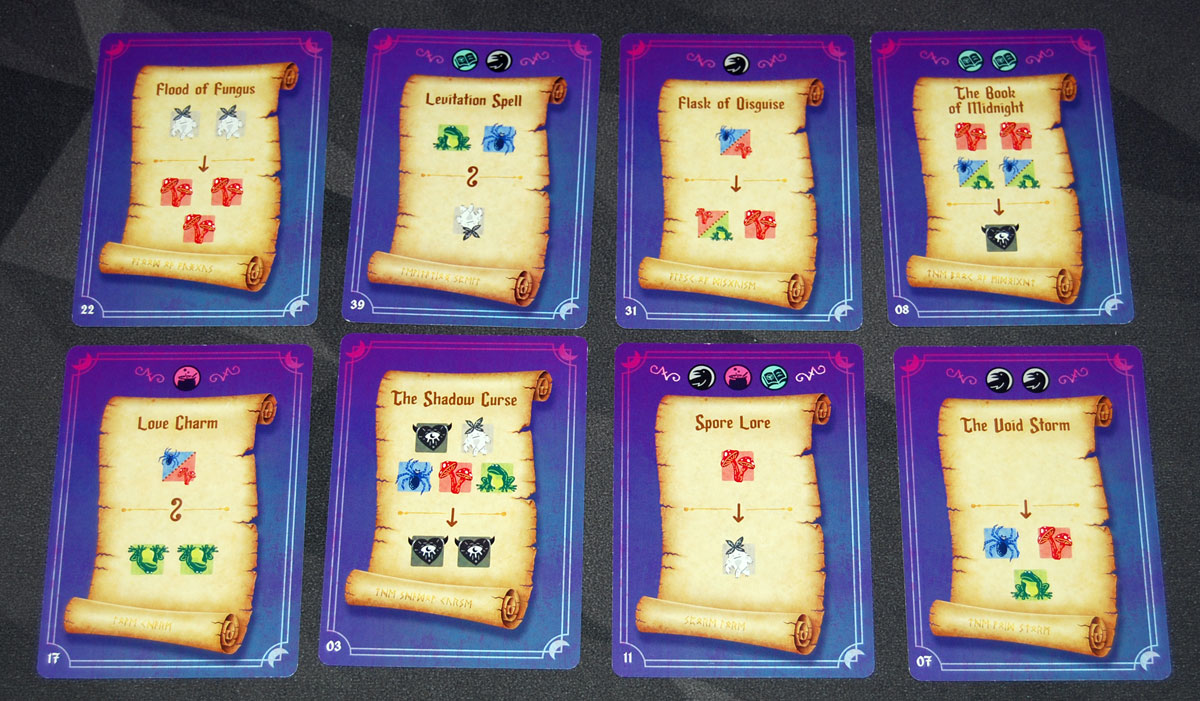
Gameplay
Each round, there are two phases: Study and Brewing.
During the Study phase, each player will choose a recipe card to play face-down, reveal recipes simultaneously, and then resolve arcana from the revealed recipes. Some recipe cards have an arrow, indicating which ingredients are the input and which are the output. Others have a little swirl, indicating that you can orient the recipe whichever direction you want, with inputs at the top and outputs at the bottom. (Note that you cannot change the orientation later.)
There are three arcana icons: a cauldron, a crow, and a book. If your recipe card has any of these, you move the corresponding arcana tokens on the track on your reference card (one space per icon). Each time a token lands on or passes an even number, you may trigger its effect. (If you choose not to trigger an effect, it’s forfeited and cannot be saved up for a future turn.) The effects are:
- Cauldron: Add 1 ingredient of any type from the supply directly to your cauldron
- Crow: Remove up to 2 ingredients from your workbench and return them to the supply.
- Book: Choose 1 ingredient type: for this round, you may take that type from the supply instead of your workbench as recipe inputs.
The Brewing phase is when you use your recipes, pass the cauldrons, and then pass recipe cards.

Each recipe card you have may be used once per Brewing phase. If you have the correct ingredients on your workbench, you may place them on the inputs on a recipe card. Then, take the indicated ingredients from the supply and place them on the corresponding output spaces. You may also use the output from one recipe as inputs for another recipe.
Once you have used as many of your recipes as you wish to, take all remaining output ingredients and place them in your cauldron. Return all used input ingredients to the supply. Then, pass the cauldron to the player to your right.
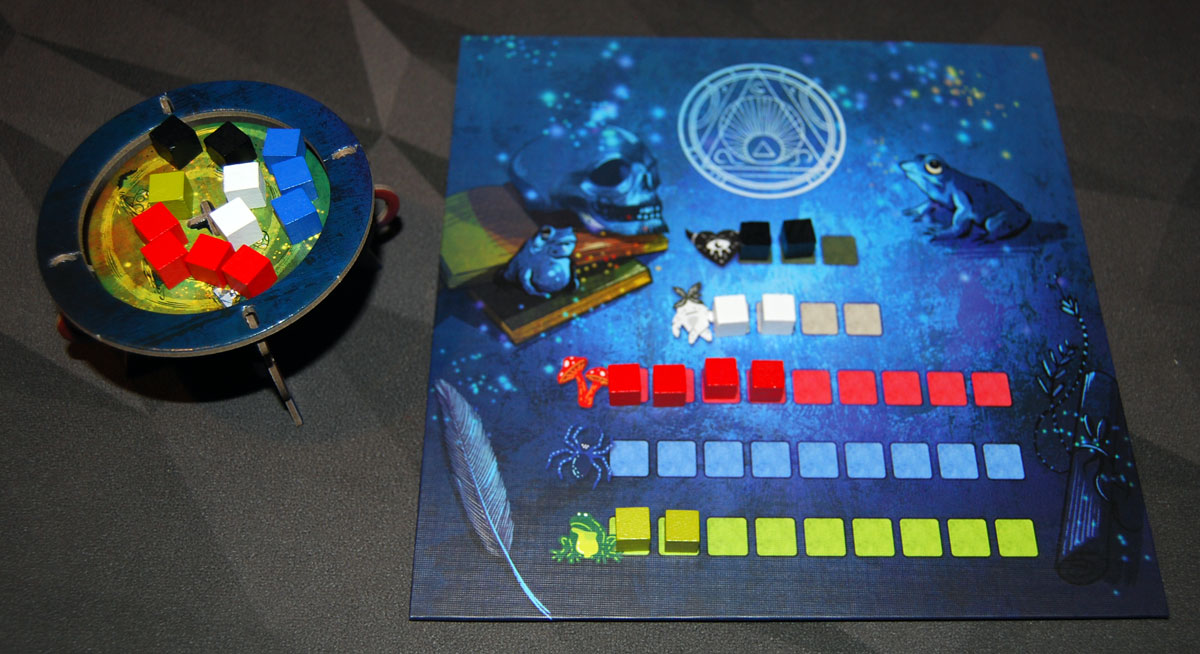
After everyone is done using recipes and passing cauldrons, everyone takes the new cauldron they have received and places all the ingredients in it onto their workbenches. If you run out of room for any ingredients, the remainder is given back to the sender, who places them into their Witch’s Circle.
Everyone passes their remaining recipe cards to the left, and then draws back up to 4 cards and starts a new round.
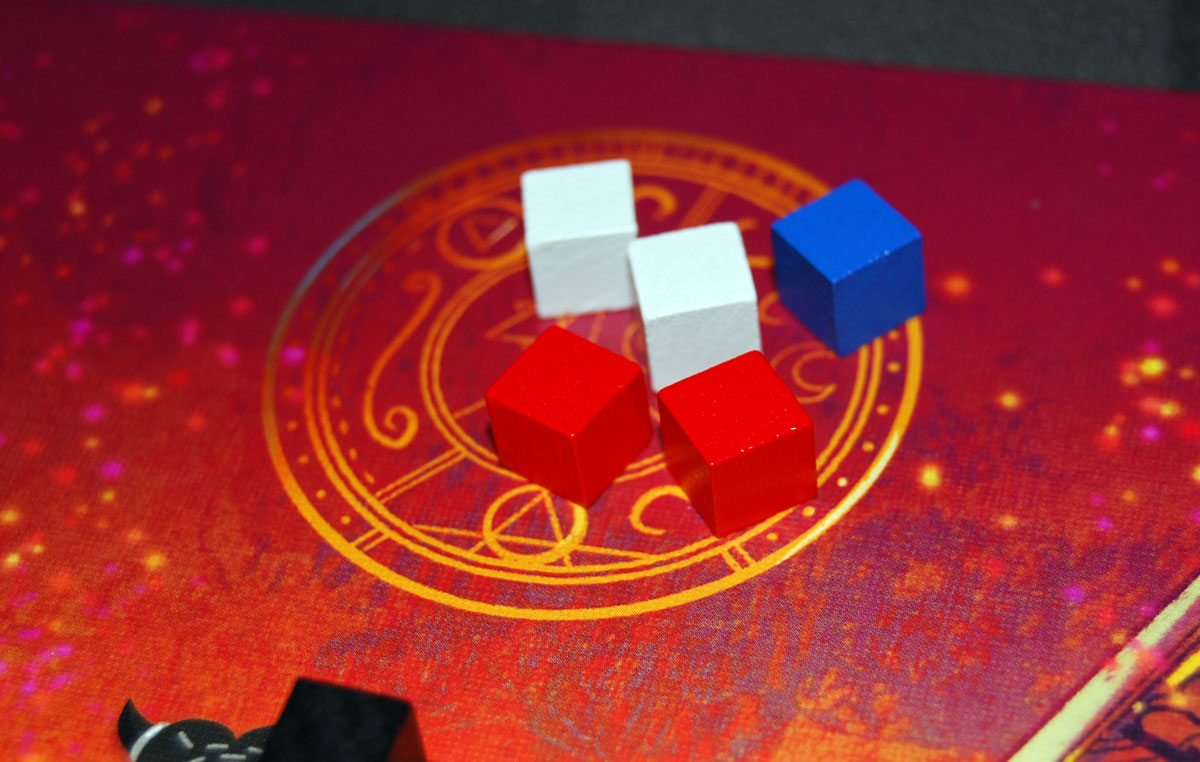
Game End
At the end of the brewing phase, if any player has 5 or more ingredients in their Witch’s Circle, they win! If more than one player reaches 5 or more on the same round, ties go to the player with more ingredients in their circle, then the most different types of ingredients in their circle, and then the fewest ingredients left on their workbench.
Why You Should Play Whirling Witchcraft
Whirling Witchcraft was published last year but I’d missed it at the time, but I’ve enjoyed my plays of it since then and thought it would be worth highlighting now that it’s spooky season! The game’s setting is abuot collecting magical ingredients and transmuting them into others while the cauldrons go round and round the table, with a sort of cautionary tale about accumulating too much power so that it blows up in your face. Of course, the funny thing is that when things do blow up in the game, it’s not entirely your fault—you can blame your neighbor, who wins by sending you more than you can handle.
As you choose recipes to put into play, there are a couple things you need to pay attention to. First, since you’re trying to overload your nemesis (to your right), you want to be able to produce a lot of the same thing. Ideally, something that they don’t have a lot of use for so they can’t place them as inputs for their own recipes. On the other hand, you need to watch the player to your left to see what sorts of outputs they have, because that’s what will overflow your own workbench. You definitely want to find recipes that will use up those ingredients. If those two criteria happen to line up, all the better!
Since the cauldrons pass to the right and the recipe cards pass to the left, you do get some control, too. If you see that your neighbor is generating a whole lot of mushrooms to send to you, perhaps you want to make sure you take the recipe that produces even more mushrooms instead of passing it to them. As for your own recipes, you can also try to starve your neighbor of the ingredients they need—sure, it may not help you directly, but if they can’t produce things, then they won’t beat you to victory.
The arcana can feel like a minor thing—some recipes have them and some do not—but don’t underestimate their power! The crow and the book balance each other a little—the crow helps you get rid of extra ingredients you can’t use, and the book helps you grab ingredients you don’t have (ideally so you can make more stuff!). The cauldron lets you just take an ingredient from the supply to send to your neighbor, so of course you’ll want to send them whatever is the most inconvenient.
There’s a nice mix of recipe cards in the deck. Some give you options for which ingredients to use. Some can take a few ingredients and generate a lot—great for overloading that cauldron—and others can take a lot of ingredients as inputs, which can really help if your workbench gets full.

It’s worth adding the more advanced personality cards as soon as everyone has learned the rules. The initiate card gives you a one-time-use ability to discard your hand and draw back up. The advanced come in two flavors: some give you a starting recipe so that you can get a head start on brewing up trouble, and the others give you powerful ongoing effects.
One of the nice things about Whirling Witchcraft is that it’s pretty quick, whether you have 2 players or 5 players, because you really only affect the people to your left and right. Adding more players doesn’t add much to the play time because each player is primarily concerned with their immediate neighbors. The trade-off, though, is that if you see somebody across the table who seems to be pulling ahead, there’s not much you can do to stop them.
Although there is some luck involved in the cards that are drawn, the drafting does mitigate that a little. Paying attention to what both of your neighbors are doing can help keep your workbench under control. We did find, however, that if you have a player who is weaker at strategizing, the game can end quickly because they overflow repeatedly, allowing the player to their left to win. I’m not sure what the best way is to balance the game when you have a mix of skill levels, but it’s also a short enough game that it can be fun regardless.
If you like games about manipulating resources and building up a big tableau of actions, give Whirling Witchcraft a spin! For more information, visit the AEG website.
Click here to see all our tabletop game reviews.
![]() To subscribe to GeekDad’s tabletop gaming coverage, please copy this link and add it to your RSS reader.
To subscribe to GeekDad’s tabletop gaming coverage, please copy this link and add it to your RSS reader.
Disclosure: GeekDad received a copy of this game for review purposes.
